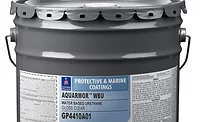Alternatives to Fluorosurfactants for Water-Based Floor-Care Coatings

art-4-art, E+, via Getty Images
The use of fluorosurfactants in coatings has increased over the years due to their performance and efficiency. They provide a variety of desirable performance features in coatings: low surface tension/energy, chemical resistance, and more. In addition, fluorosurfactants tend to be highly efficient, allowing for low usage levels and, despite their expense, they present a reasonable cost in use-value for the coating formulator.
In recent years, however, regulatory pressure has increased around the use of fluorosurfactants in various industries.
To respond to the changing regulatory environment around the use of fluorosurfactants, an examination of alternative technologies was conducted, with specific focus on water-based floor care coatings, as this is a market segment that may be significantly impacted. The intent was to lay the groundwork for potential transition of such formulations away from the use of fluorosurfactants.
In the floor-care industry fluorosurfactants have been used exclusively in low-solids, low-viscosity water-based formulations to provide flow and leveling, and thereby enable a smooth film profile with good gloss and appearance. This is particularly important as these coatings are typically applied layer by layer over a low-energy substrate. Here, the surfactant must provide sufficient lowering of surface tension in the coating to enable the first layer to initially wet out the substrate and then for each successive layer to wet out the previous layer as well. All this must be achieved while providing good leveling characteristics so that minimal texture is developed during the floor-care application process. The goal is to have a smooth, relatively defect-free surface, as shown in Figure 1.
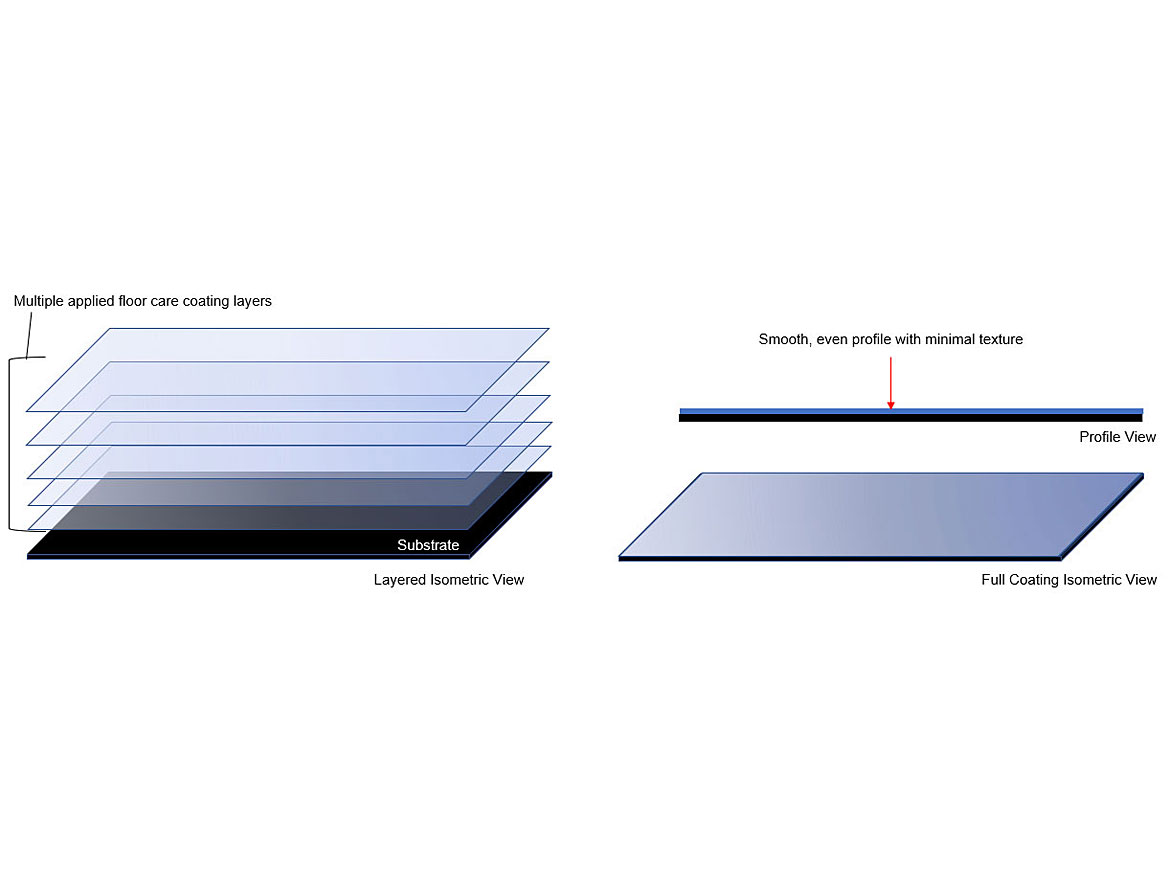
In addition, the coating must not have a significant slip component. This is extremely important from a safety perspective, as the coatings will ultimately see pedestrian foot traffic. In a non-ideal application, the coating will typically exhibit insufficient leveling performance at some intermediate layer, which is then propagated with subsequent layer application. This may be further complicated with additional sites of insufficient leveling occurring during the process as layers build up (Figure 2). In the end, the result is a coating application that shows unacceptable surface texture or lack of smoothness. The gloss may also be impacted.
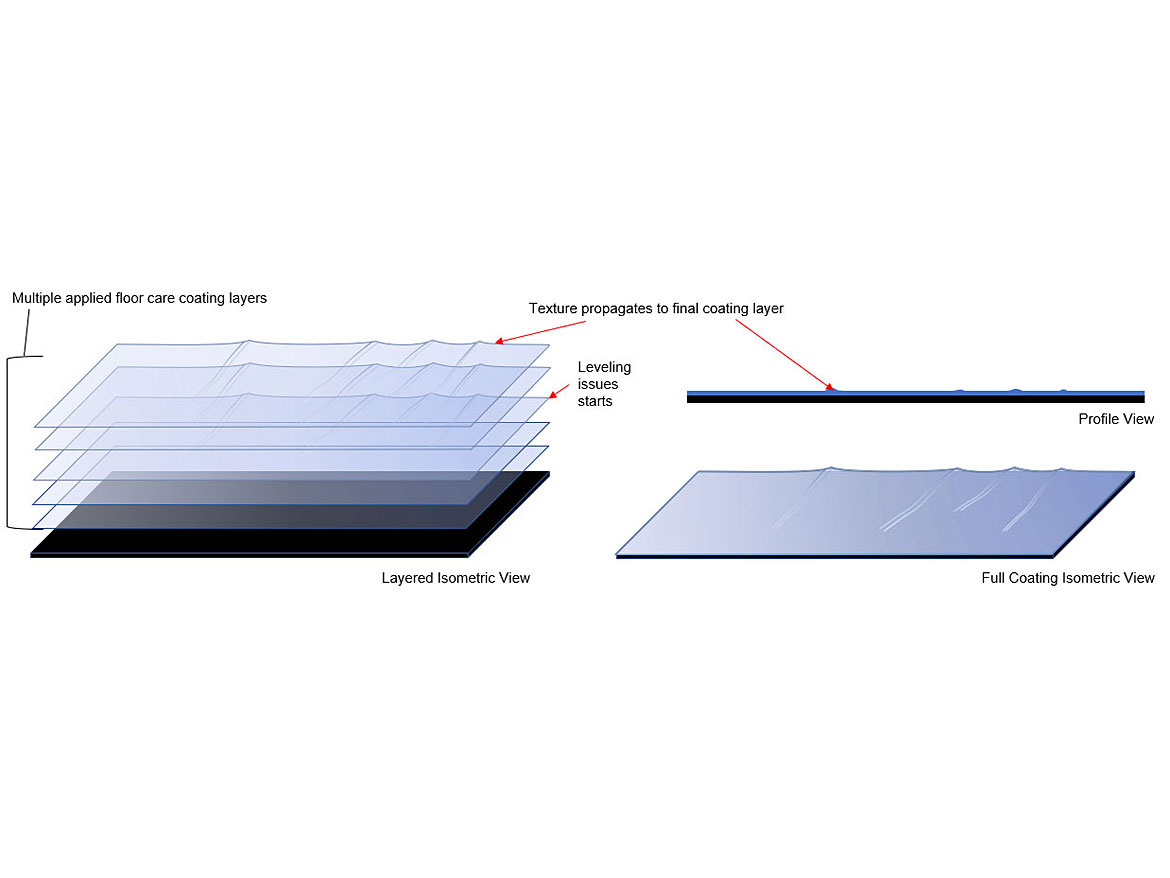
One hypothesis to explain the phenomenon is that the surface energy may be decreasing with each successive layer application. If this were true, it would potentially impact the leveling effect, resulting in longer times required for the leveling process to complete in each layer. This would be subject to evaporation and curing, which may occur on a faster timeline. Hence, the incomplete leveling of the coating would be locked in.
Experimental Design
Alternative Surfactants
A variety of surfactant chemistries that provide good wetting and leveling attributes were screened as potential replacement for fluorosurfactants (Table 1). Potentially synergistic blends of surfactants were also included as part of the screening set.
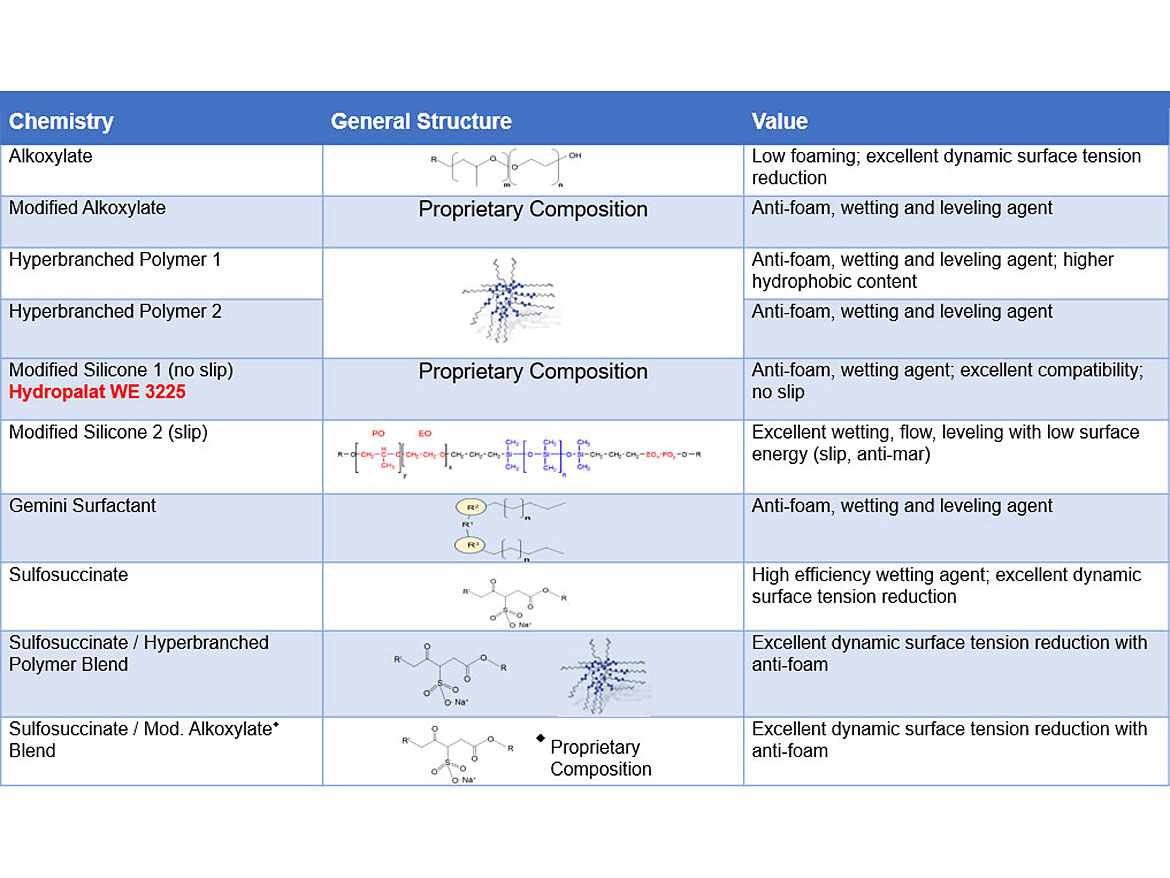
Formulation
Each surfactant was evaluated in a water-based floor-care-coating starting point formulation based on a commercial acrylic resin. These were compared with a commercial fluorosurfactant (control) that is commonly used in floor-care coatings, with an active content loading of 0.01% by weight (Table 2).
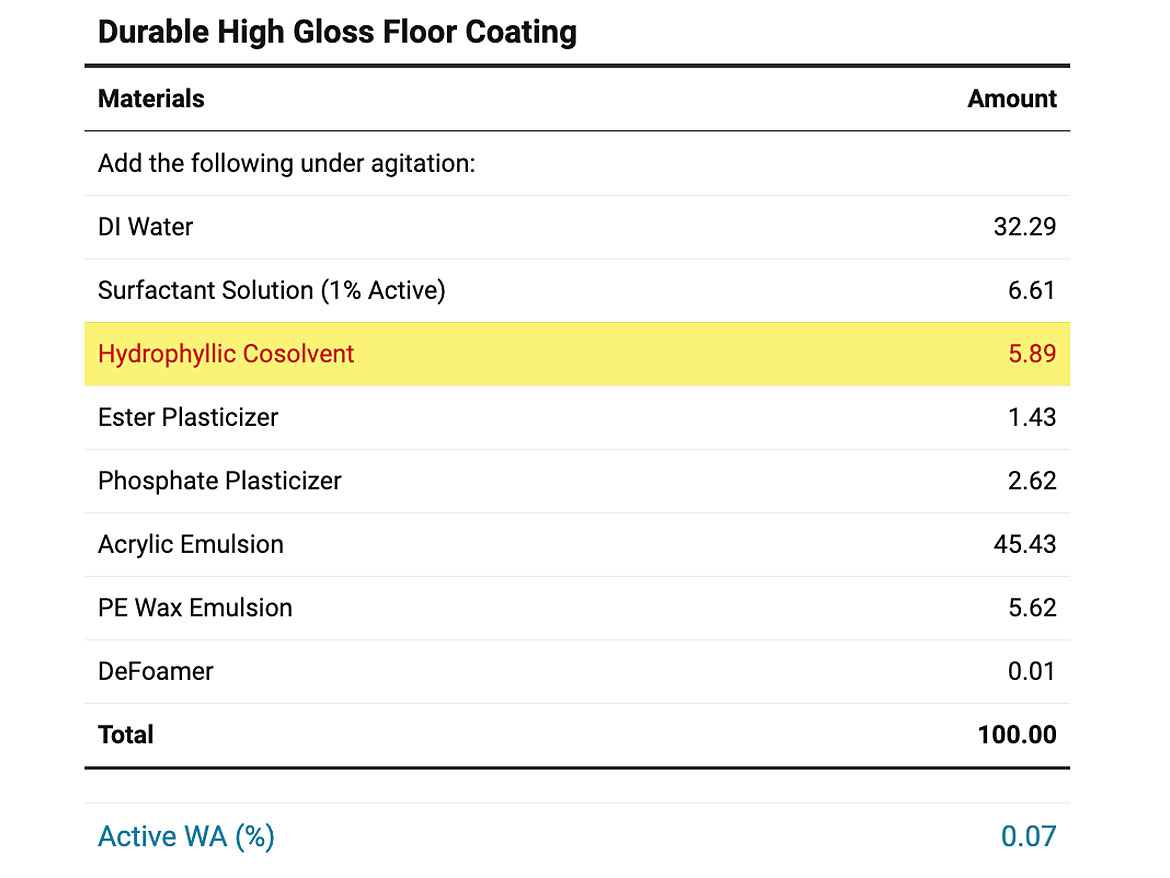
Initial Screening and Benchmarking of Surfactants
Benchmarking was done using Dynamic Surface Tension (DST) to compare performance of a control formulation with 0.01% fluorosurfactant against those of surfactant candidates at three concentration levels to scout the performance space: 0.01%, 0.10%, and 0.50% actives by weight on total formulation.
VCT Application Evaluation of Best Candidates with Optimization of Levels for Performance
From this work, those surfactants that demonstrated the most consistent performance equal to or better than the fluorosurfactant control were then advanced to lab application trials on vinyl composite tiles (VCT): Armstrong® Standard Excelon® Imperial Texture 51910021 C132B. Here the applications included five successive layers applied with cheesecloth, allowing each layer to dry to touch (typically 30 minutes, depending on humidity and temperature conditions). The VCT applications were subsequently visually assessed and ranked. The top-ranked formulations were then further optimized for surfactant concentration versus flow and leveling performance.
Additional Factors Explored
Additionally, the best performing surfactant formulations were examined for different aspects/factors:
- Alternate application method: using a squeegee or fiber mop, which is more representative of a true commercial floor application.
Results
Initial Dynamic Surface Tension Screening
DST provides a useful measure of not only the static surface tension, but also a measure of the stability of the solution surface tension under more dynamic situations. As bubble frequency increases and the solution becomes more turbulent, the surface tension will tend to rise. The premise that each surfactant at a given concentration will yield a characteristic DST curve serves as a good basis for comparison of the ability of different surfactants to suppress surface tension in a coating solution and the degree of surface tension stability provided by each. Figure 3 shows a comparison of 0.01% fluorosurfactant to the surfactant candidates at 0.01%.
Surfactants were rated based on their DST results based on the following criteria when compared to the fluorosurfactant:
- Equal or lower static surface tension.
- Equal or better surface tension stability under dynamic conditions.
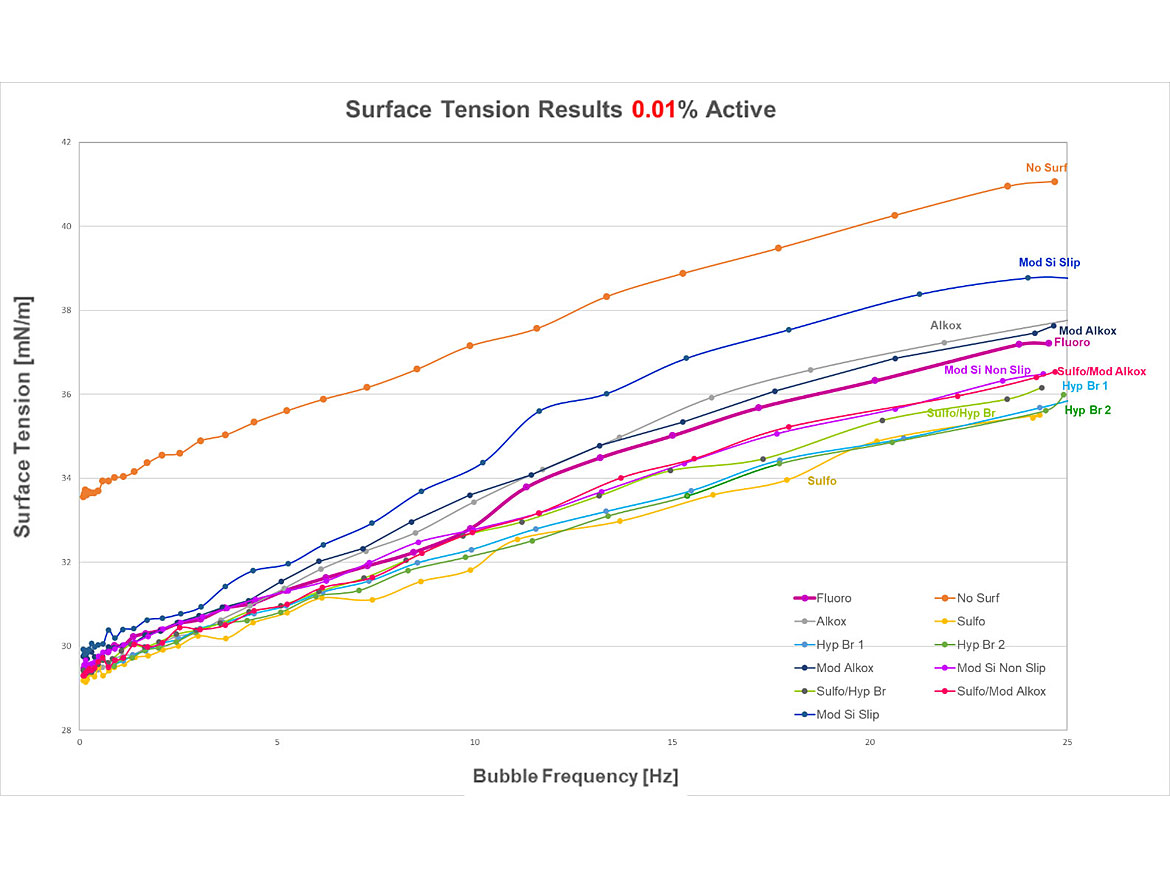
Depending on the concentration level, a variety of surfactant candidates met these criteria. The general findings of this work are summarized in Table 3.
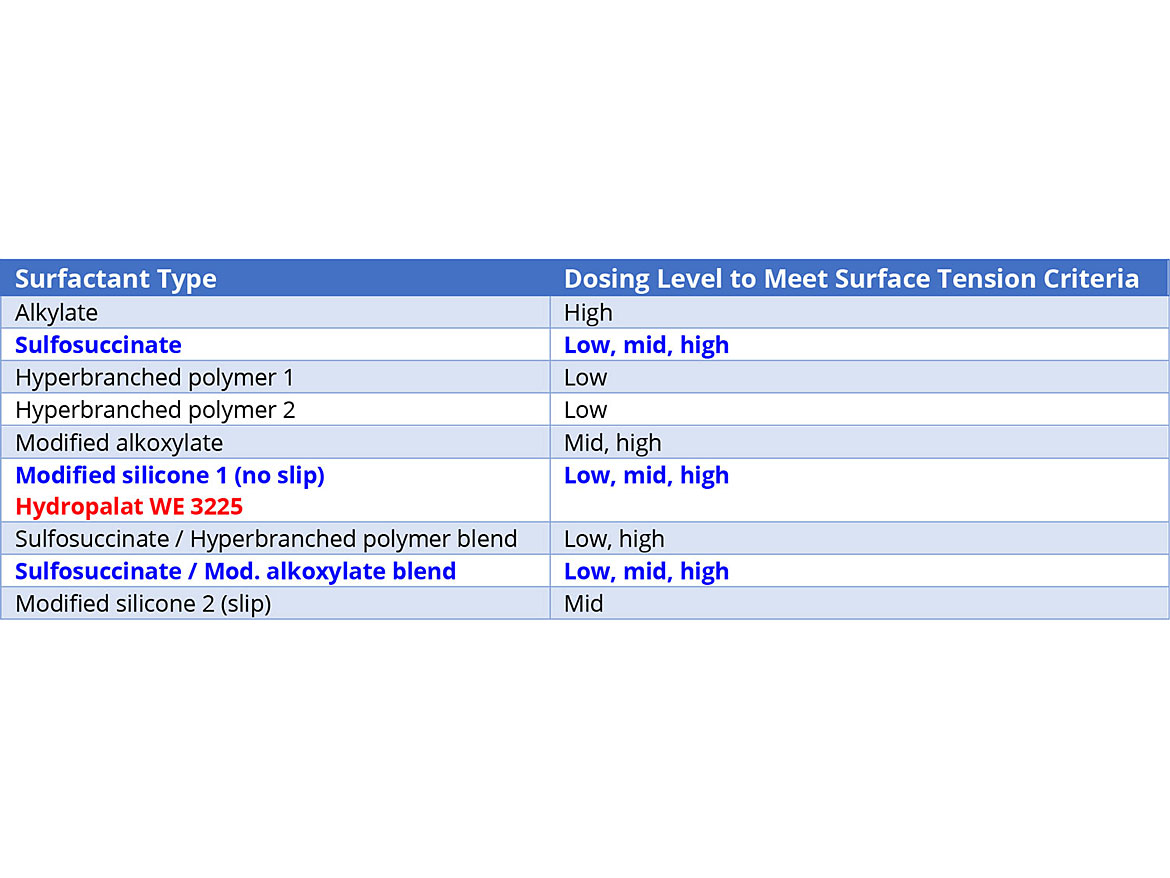
As seen in the results above, the sulfosuccinate, modified silicone (no slip) hydropalat WE 3225, and the sulfosuccinate/modified-alkoxylate blend were the most versatile (“best performers”) for surface tension suppression and dynamic stability.
Vinyl Composite Tile Application Trials and Surfactant Level Optimization
In Figure 4 below, photos documenting selected coatings applications with given surfactants are shown. A selection of coatings from an early experimental application set are shown, with visual rankings (1 = best; 12 = worst). Included for comparison are the coating formulation containing fluorosurfactant and a blank formulation containing no surfactants. Here the formulation containing 0.1% of a sulfosuccinate and modified-alkoxylate surfactant blend provided the best overall coating experience, approaching the appearance of the fluorosurfactant control. Criteria that went into the rating of each coating included: leveling (smooth film appearance), presence of craters, and unusual flow formations. Note that some artifacts seen in some of the photos are actually fiber remnants from the cheesecloth, which were deposited during application of the coating. These did not factor into the visual assessment. In addition, the visual assessment was done by more than one person to normalize the assessment result and reduce the effect of individual bias.
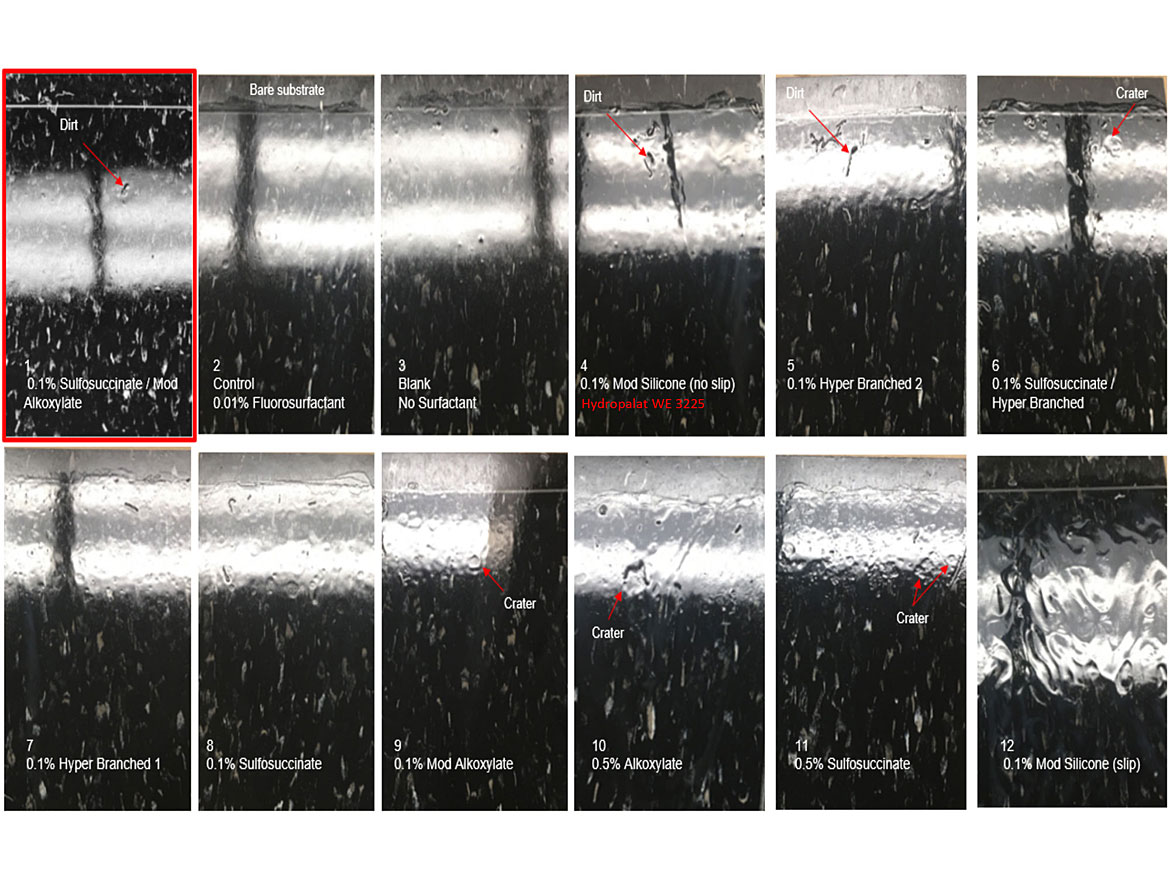
The best candidate surfactants determined by DST were optimized by concentration for best flow and leveling performance. In addition, a new surfactant type, a gemini surfactant, was included in the evaluation. From this process, four candidates were selected as having the best overall performance relative to the fluorosurfactant control. Photos of these surfactants and their concentrations are shown in Figure 5.
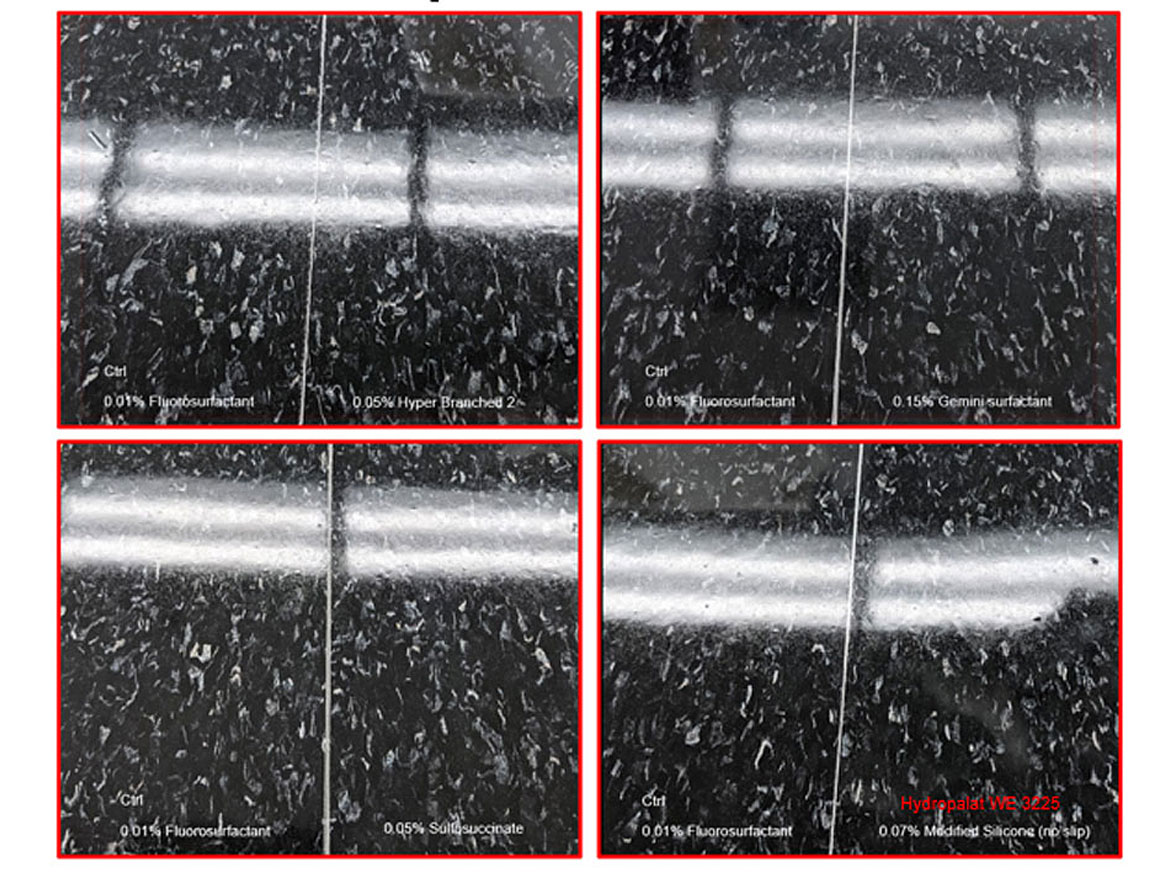
Note in each photo that the VCT panel has one half applied with the fluorosurfactant formulation (left side) and the other half with the surfactant candidate formulation (right side). This allows for easy comparison of the candidates to the control, while eliminating experimental variables of substrate panel differences, application time, coating cure time, etc. Here, Armstrong® Standard Excelon® Imperial Texture 51910021 C132B VCT was used. For the best surfactant candidates, the gloss measurements proved to be similar at both 20° and 60° relative to the fluorosurfactant control, shown in Figure 6.
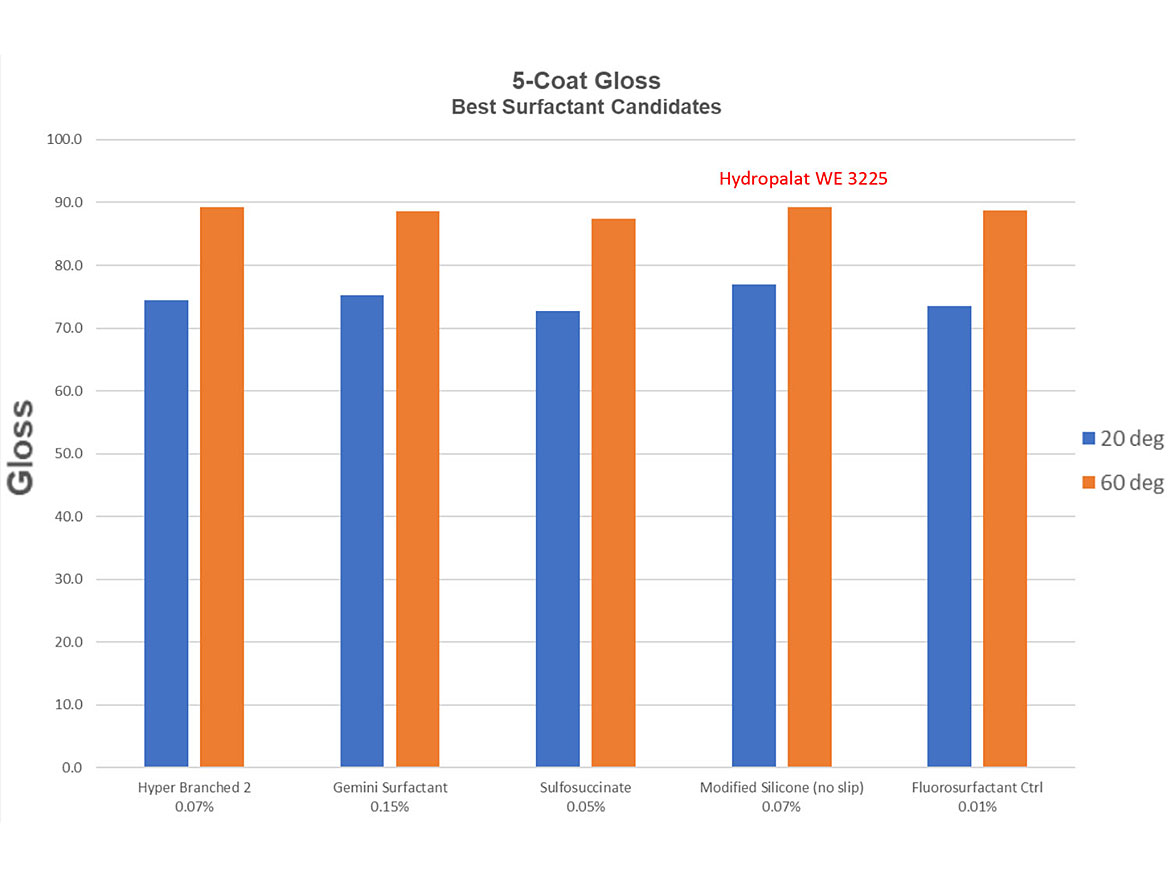
Additional Factors Explored
Squeegee/Fiber Mop Application
Figure 7 shows the results of applying the different surfactant floor-care coatings using a squeegee or fiber mop, which is more representative of a commercial application. Here, Armstrong Standard Excelon Imperial Texture 51910021 C132B VCT was used. It was noted that some of the candidates left more of a texture in the coating than they had displayed when using cheesecloth. Most notable was the 0.1% sulfosuccinate/modified-alkoxylate where there were significant swirl patterns evident in the coating. To a lesser degree, the 0.07% hyper branched 2 surfactant also showed some of this phenomenon. The 0.07% modified silicone (no slip), hydropalat WE 3225, surfactant yielded the smoothest appearance of the surfactant candidates chosen and closest in performance to the fluorosurfactant control, which had the overall best appearance.
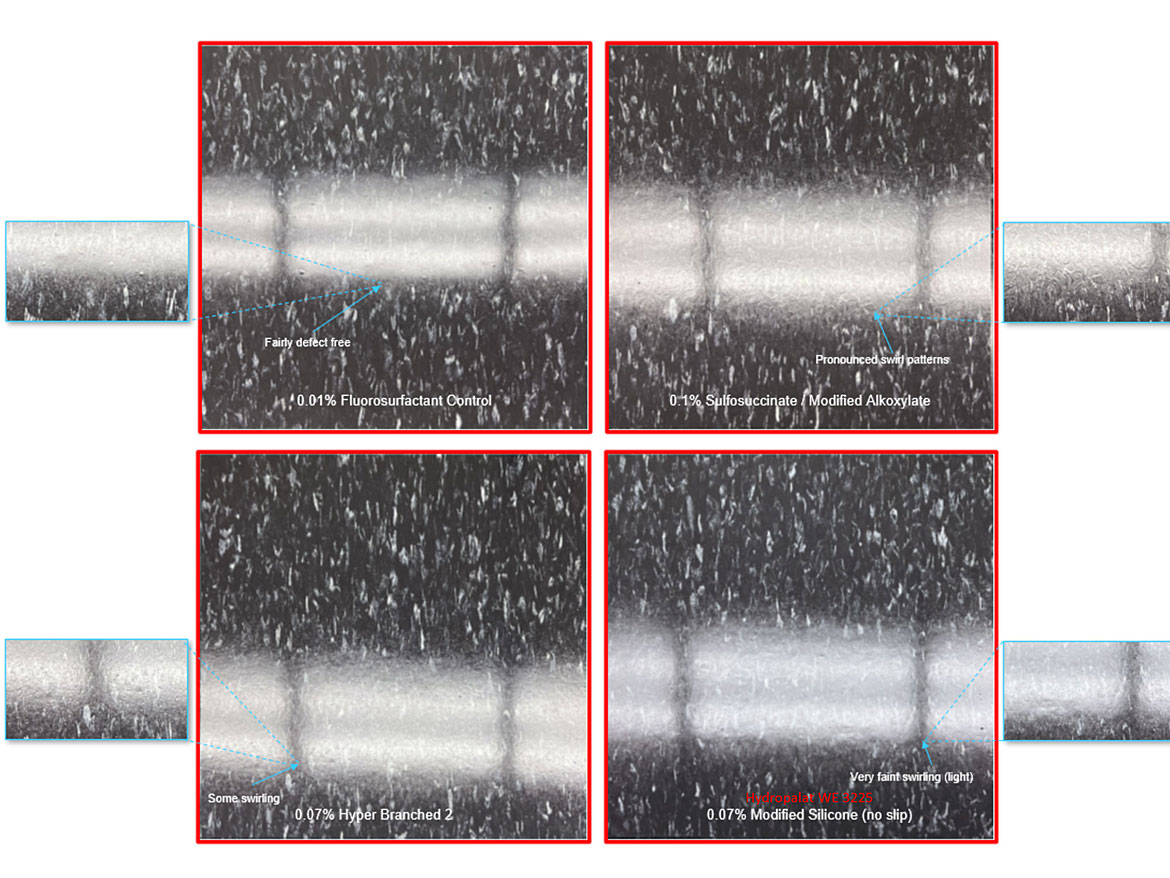
From this, it is apparent that coating performance may differ when going from cheesecloth (lab) to squeegee (real world) application. Noting this difference, it is recommended to always trial candidate formulations through squeegee application method as a final check on formulation performance.
Conclusion
Replacement of fluorosurfactants in floor-care coatings has proven to be very challenging. Several classes of surfactants have shown promising results with performance approaching that of fluorosurfactants for a five-coat floor-care coating application. In particular, hydropalat WE 3225, a non-slip modified silicone surfactant, proved to yield the best coating appearance (flow and leveling) of the alternative chemistries examined.
While this work is pertinent to water-based floor-care coatings, it is likely that it can be leveraged towards wood and industrial coatings applications, as well. The results of this work demonstrate the possibility of replacement of fluorosurfactants. With the concern around fluorosurfactants continuing to grow, this work is of special relevance for future developments in coatings.
Looking for a reprint of this article?
From high-res PDFs to custom plaques, order your copy today!






